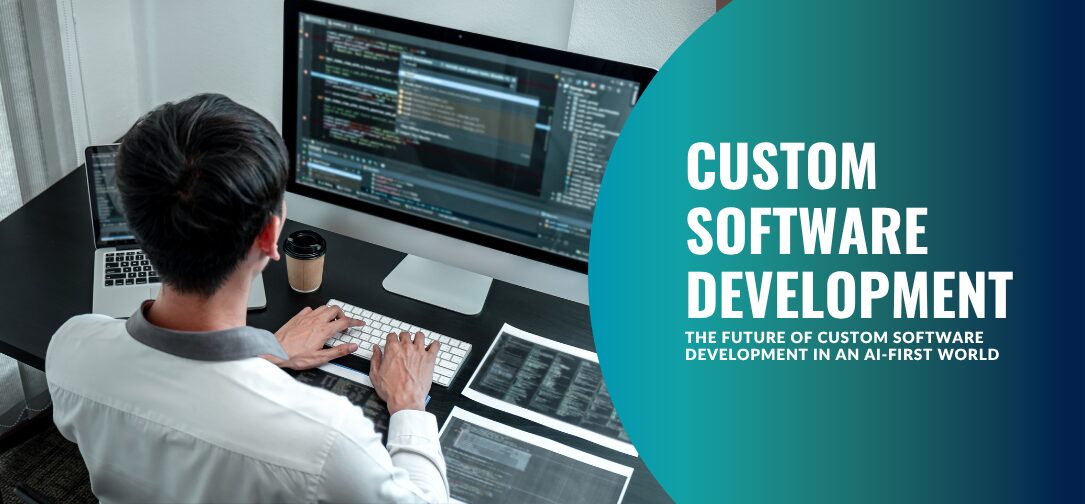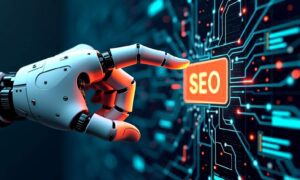There is now a strong emphasis on artificial intelligence in the business world, where it affects everything from planning a product’s development to providing services to customers. Nowadays, organizations have stopped questioning if they need AI and focus on how fast they can implement it in their major activities. This transformation made some people think that the custom software development industry would suffer because of AI.
Contrary to these predictions, custom enterprise software development has not become obsolete. As a result, it is now more sophisticated and important than it used to be. AI, automated decisions, and intelligent designs characterize what custom software now involves. Instead of substituting custom-made software, AI has given us new approaches to meet companies’ distinctive needs in software. Let’s have a closer look at how software development looks in the AI-assisted industry.
Why Companies Should Not Give Up on Custom Software Even with AI
Though off-the-shelf software seems simple and cheap at the start, it still cannot meet all the detailed and specialized needs of today’s companies. These standard tools are not usually flexible enough for different business needs, struggle to cope with the growth of an organization, and do not link easily to programs built for the business long ago.
It is most obvious in sectors that grow strongly. In healthcare, custom enterprise software enables AI integration for predictive diagnostics, personalized treatment recommendations, and automated compliance monitoring. Travel companies use their own applications to set up responsive prices and personalize the user experience. Fintech companies design their unique fraud detection software and risk identification tools to learn about their users’ habits from their activities. These companies build systems that improve the route planning process and forecast demand, taking into account their own rules and changes in the market.
No one can build these applications with ordinary software since they need knowledge about what is happening in the industry, which regulations to follow, and who the competitors are. AI playing a role in these systems has to be trained and tailored to each business’s different requirements based on the right data sets.
AI’s Effect on Modern Custom Software Development
AI Helping in Development
Productivity and the standard of code have improved greatly due to AI tools in the development process. Examples of these platforms are GitHub Copilot, ChatGPT, and Tabnine. They have become an important part of a developer’s tools because they can assist in coding by offering code snippets, hints for improvements, and the creation of entire functions dependent on simple descriptions. These tools have dramatically accelerated the development of minimum viable products and prototypes, allowing any software development company to iterate more rapidly and test concepts with reduced time investment.
The use of AI in test automation is now vital, since it generates test scenarios, finds possible weaknesses, and spots bugs before they are released in production. It’s not only about single-unit testing but also about dealing with integration and ensuring proper user experience, which cuts down the time spent on manual testing and creates much more reliable software.
How fast one can work has a major effect on development. Effective use of AI has enabled teams to become more productive by up to 50%, yet specialists advise extra care to make sure the code is always of good quality.
Products Incorporating AI
Even more important than AI’s work in development could be its usefulness as a major part of a software solutions company‘s offerings. Today’s custom applications usually use tools that suggest what users might be interested in, supply automated customer assistance, estimate future trends, and instantly detect signs of fraud.
Such capabilities are made possible with the use of advanced AI APIs and platforms based in the cloud, for example, from OpenAI’s GPT models, Google’s Vertex AI, and AWS Bedrock. Software companies can deploy advanced AI using up-to-date tools instead of building their own machine learning designs, sharing these abilities with many people.
As a result, software no longer only works with data but also considers situations, learns from the way it is used, and gives ideas that guide key business decisions. As a result of this development, custom software is now more valuable as it provides a business with an advantage over its rivals.
Architecture and Infrastructure Powered by AI
Today, AI allows organizations to efficiently use their resources and prepare for future capacity, while their applications are scaled up or down according to how much they are used. Machine learning has been added to DevOps processes to analyze how things are deployed, pinpoint areas that could fail, and also advise on how to fix problems and improve.
Because of AI-driven personalization, user experience design has evolved a lot. Now, applications are able to adjust their look, content, and behavior according to how each user acts, so every person feels important while the main experience stays the same across the user base.
Shift in Team Design and Skills Needs
Because AI is part of custom software, teams working on such projects now need different skills and people. Now, data scientists and machine learning engineers are part of specialized teams with frontend and backend developers, so the groups can unite their software skills and knowledge about AI.
There are now experts called “AI-savvy developers” who can blend machine learning with software systems, along with “software-aware data scientists” who make models that operate well in wider software systems. Companies are putting a lot of effort into ensuring their workers are trained in more than one area.
Since AI is changing constantly, those who work with it must keep learning and improving their skills. Those that manage the change best encourage teamwork so that technical teams can assist and benefit from each other as they learn and try out new things.
AI-Brought Dangers and Risks
Even though AI is expected to have a big impact, bringing it in comes with many issues that must be handled properly. Since applications handle more and more private information, privacy concerns have become extremely important. Entreprises should set up strong systems of rules so that their AI systems follow regulations like GDPR and CCPA as they depend on access to data.
Also, AI may reinforce the biases seen in its training data, another important risk. This is most worrying in programs that control people’s access to goods, services, or opportunities in life. The entire development process should include ways to find and reduce biases.
It has become much harder to integrate software as teams try to join traditional software with AI models that could be uneven in how they work, update, and fail. It is necessary now to design systems, test them, and monitor results to deal with the unpredictable aspect of AI outcomes.
Having enough money and qualified people is still a constant issue. Those who know how to develop AI need higher pay, and the computers used for the work are often expensive. As AI is integrated into organizations, managers should compare the pluses and minuses of its impact on costs and try to produce their own solutions to decrease their dependence on outside help.
AI-based code is leading to the rise of a new issue in the field. Although AI tools help with development, the code written may be tough to handle, may lack documentation, and could be hard to fit into the future architecture. Team members should set up steps that guarantee using AI doesn’t compromise the quality of the developed code.
AI as a Basic Layer in Software
The next step is to combine traditional and AI-based ways of building software, instead of choosing between them. AI is now regarded as a basic layer in software architecture, the same as databases, user interfaces, or security frameworks in terms of how vital it is for application performance.
Companies that notice this change and focus on AI as their main skill will be able to develop software that consistently brings them an edge in the competition. They need to continue their education, use new technologies, and improve the knowledge of their professionals who are skilled in coding and AI.
Those businesses succeeding in their industries will view AI as a main building block in their custom development strategy. An application made by a web application development company that knows how to intertwine AI with more traditional approaches like GP Solutions is destined to deliver results to its users, and its value will propagate with time as technology keeps on evolving.
The use of AI is slowly taking software development to a new level rather than making a drastic change overnight. The need to find custom solutions for different business problems does not change, but the resources to achieve this have grown a lot. This environment calls for using AI to speed up development and support the product, while zooming in on making the software reliable, easy to maintain, secure, and useful for users.
Those able to utilize AI’s effects properly and smartly have a good chance in the future marketplace. As a result, they will make software that not only automates current processes but also provides new opportunities for meeting customers’ needs.



































